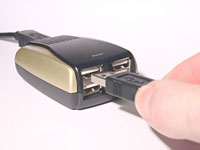Please note - Ndiyo has now officially closed its doors, at least as a legal entity - but we've kept the site alive in case any of the information is useful to others.
Our thanks to all those who helped out and were involved in so many different ways! The Ndiyo legacy lives on in the ultra-thin-client work at its spin-off DisplayLink, at Plugable, at NoPC and elsewhere...
Hubster - A User-configurable Terminal
There's another reason why Hubster is an attractive model...it solves a real problem for thin clients.
Anybody designing traditional thin client devices has to face the question of how many different types of peripherals to support. The more provision you make for audio, video, attached storage, printers, joysticks, and all their associated software drivers, the more complexity and cost you add to the device. If you go too far, you might as well buy a PC. By leaving them out, you can create an elegant, low-power device like the Ethernet Nivo, but it may not be suitable for all users' needs.

With Hubster, the thin client is just a hub. It's as thin as you can possibly make it. A typical Hubster terminal comes from plugging a keyboard, screen and mouse into the hub. But if a particular user needs Skype, then you can plug a USB headset into their hub. Another user might plug in a USB flash drive. Another may want more than one screen. It's the central PC that's providing support for the peripherals, and the Hubster software that's allocating them to the sessions of individual users. This can often be done completely automatically.
Hubster is the first ultra-thin-client terminal with completely user-configurable hardware!
